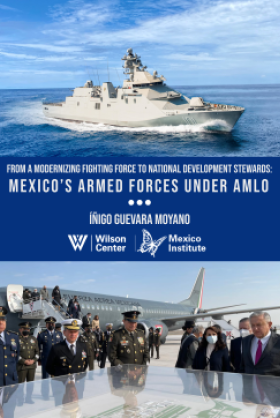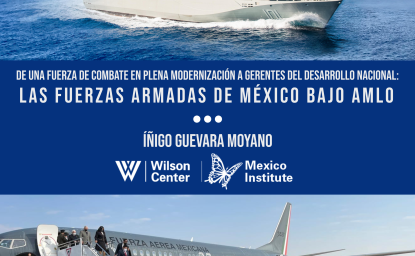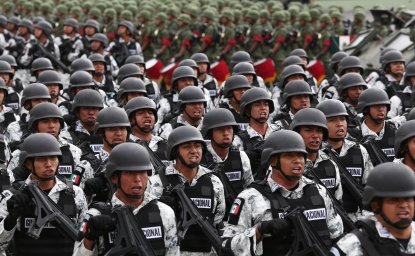From a Modernizing Fighting Force to National Development Stewards: Mexico’s Armed Forces under AMLO


Foreword
Designed for national security, the Mexican Armed Forces –Army, Air Force, and Navy– have in recent years acquired a more preeminent role in Mexican politics and policy. While never entirely absent from public life, their role in counternarcotic and counterinsurgent operations has been amply documented. Today the armed forces build airports, clean up seaweed, and lead the “fight against organized crime.”
Their rising preeminence and involvement in the “war on drugs” has been accompanied by growing concerns of Mexico’s militarization and egregious human rights violations. For over a decade, international organizations such as Human Rights Watch and Amnesty International[1] have documented abuses committed by the armed forces while combatting organized crime. Mexican scholars and civil society organizations have also voiced their evidence-based concerns toward issues ranging from the high levels of lethality[2] –the Army kills more people than it wounds or detains– to increasing homicides against women[3] and expanding duties that are hard to justify under national security or even public safety tasks.
Yet, the question of Mexico’s militarization and the expanding role of the armed forces is not as straightforward as public debates would suggest. This article by Iñigo Guevara is an indispensable intervention on current discussions about militarization in the country. Guevara’s work shifts the focus from whether the Armed Forces should be involved in combatting organized crime and its consequences to understanding the Army and Navy’s modernizing ambitions and how they are linked to their role as an increasingly active and more visible player in Mexican political life.
The reader, whether an expert on security or broadly interested in Mexican affairs, will find at least three takeaways in this article:
First, it shows that militarization is not a process being directed from the Executive branch and blindly followed by the Army and the Navy. Popular narratives about Mexico’s “war on drugs” often include discourse around “Calderón’s war” and, more recently, the closeness of President López Obrador with the armed forces. However, as evidenced by their own internal documents analyzed by Guevara and presented in this article, the armed forces are aware of the concerns their expanding role generates among scholars and civil society, crafting their message and budget requests accordingly. For instance, the purchase of equipment used in maritime patrols and intelligence gathering was requested as Assets of Rescue Operations. In this sense, it is imperative we start thinking about the agency the armed forces exercise vis-à-vis the Executive and Legislative branches. As evident as it may seem that the armed forces actively pursue their own agenda, Guevara’s work sheds light as to how this process has been conducted and how to keep track of it.
Second, and building on the notion of agency, Guevara’s work challenges the idea of militarization as a continuous process bolstered during President Calderón’s administration and uninterrupted up to the current López Obrador presidency. Guevara compellingly shows that while the Army and the Navy are increasingly involved in more tasks, from building railways and welfare banks for distributing social benefits, this has come at the expense of an agenda that sought to modernize and acquire more material capabilities. This, Guevara shows, is an important departure from the Calderón and Peña years where the armed forces could pursue their modernization efforts. The trademark, therefore, of the López Obrador administration is the inclusion of the armed forces into an economic agenda that has created revenue generating opportunities. Consequently, while we can discuss what currently seems like an ever-expanding role of the armed forces, the evidence presented here denotes that this process of militarization has been more complex and less linear than assumed.
Third, Guevara’s work is an invitation to examine critically why the Army and the Navy enjoy the highest levels of trust among the general population. The most recent data from Mexico’s Victimization Survey[4] shows that 90.2% and 87.8% of the population trust “a lot” or “somewhat” the Navy and the Army respectively. Currently, these high levels of trust are explained in relation to perceived low levels of corruption. This is to say that to the extent that the Army and the Navy are seen as incorruptible institutions, the general population will trust them more.
Data from the Survey on Democratic Quality[5] (ENCADE per its Spanish acronym), however, suggests dynamics are more complex than corruption alone. For example, 77% of the general population trusts the armed forces for the distribution of COVID-19 vaccines, 67% trusts them to fight criminal groups, while 56% trusts them to build a new airport. Notably, 52% believes the armed forces cut deals with organized crime. Considering the agency the armed forces exercise and the revenue-generating opportunities they continue to receive, it is important to analyze under which circumstances they enjoy high levels of trust. This is not only relevant for understanding when citizens trust the armed forces but also whether conditions for transparency and accountability will exist or be undermined.
As lethal violence remains unabated in Mexico and the functions of the armed forces continue to expand, Guevara’s research is an essential read in debates of militarization. The reader will find robust research shared in an accessible and compelling manner.
Dr. Cecilia Farfán-Méndez
[1] See for example “Surviving death: Police and military torture of women in Mexico” (2016) https://www.amnesty.org/en/documents/amr41/4237/2016/en/ ; “Neither Rights Nor Security: Killings, Torture, and Disappearances in Mexico’s “War on Drugs”” (2011) https://www.hrw.org/report/2011/11/09/neither-rights-nor-security/killings-torture-and-disappearances-mexicos-war-drugs
[2] See “La letalidad del Ejército mexicano” (2022) available in: https://politicadedrogas.org/documentos/20220223_130037_ct39letalidaddelejercitomex.pdf
[3] See: “The Two Wars:The Impact of Armed Forces Confrontations in the Murders of Women in Mexico (2007-2018)” (2020) available in: https://drive.google.com/file/d/1WgbPwyXtmTaesXGLXm0a-Y6JcbVNJUbB/view
[4] Encuesta Nacional de Victimización y Percepción sobre Seguridad Pública (ENVIPE 2021) https://www.inegi.org.mx/programas/envipe/2021/
Author

Contributor


Mexico Institute
The Mexico Institute seeks to improve understanding, communication, and cooperation between Mexico and the United States by promoting original research, encouraging public discussion, and proposing policy options for enhancing the bilateral relationship. A binational Advisory Board, chaired by Luis Téllez and Earl Anthony Wayne, oversees the work of the Mexico Institute. Read more

Explore More
Browse Insights & Analysis
Tenth Annual U.S.-Mexico Security Conference Resource Page


